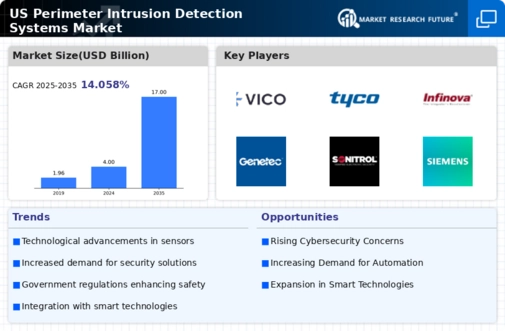Rising Security Concerns
The increasing frequency of security breaches and unauthorized access incidents has heightened the demand for advanced security solutions. Organizations across various sectors, including government, commercial, and residential, are prioritizing the implementation of perimeter intrusion-detection-systems to safeguard their assets. The perimeter intrusion-detection-systems market is projected to grow as businesses recognize the necessity of robust security measures. In 2025, the market is expected to reach a valuation of approximately $3 billion, reflecting a compound annual growth rate (CAGR) of around 8%. This trend indicates a strong commitment to enhancing security protocols, thereby driving the perimeter intrusion-detection-systems market.
Technological Advancements
Innovations in technology are significantly influencing the perimeter intrusion-detection-systems market. The integration of advanced sensors, video analytics, and IoT capabilities is enhancing the effectiveness of intrusion detection systems. These technological advancements allow for real-time monitoring and rapid response to potential threats. As organizations seek to leverage these technologies, the market is likely to experience substantial growth. The introduction of smart sensors and automated systems is expected to increase efficiency and reduce false alarms, which are critical factors for end-users. Consequently, the perimeter intrusion-detection-systems market is anticipated to expand as businesses invest in cutting-edge security solutions.
Regulatory and Compliance Pressures
The perimeter intrusion-detection-systems market is also influenced by regulatory and compliance pressures that mandate enhanced security measures across various industries. Organizations are required to adhere to stringent security standards to protect sensitive information and critical assets. This regulatory landscape compels businesses to invest in advanced perimeter intrusion-detection-systems to ensure compliance and avoid potential penalties. In 2025, it is projected that compliance-related investments will constitute approximately 20% of the overall market expenditure. As companies strive to meet these regulatory requirements, the perimeter intrusion-detection-systems market is likely to experience sustained growth.
Increased Investment in Infrastructure
The ongoing investment in infrastructure development across the United States is a key driver for the perimeter intrusion-detection-systems market. As new facilities, transportation networks, and public spaces are constructed, the need for effective security measures becomes paramount. Government and private sector initiatives are focusing on integrating advanced security systems into these developments. In 2025, the infrastructure sector is projected to allocate over $1 trillion towards modernization efforts, which includes significant funding for security technologies. This influx of capital is likely to bolster the perimeter intrusion-detection-systems market, as stakeholders prioritize safety and security in their projects.
Growing Demand from Critical Infrastructure
Critical infrastructure sectors, such as energy, transportation, and telecommunications, are increasingly adopting perimeter intrusion-detection-systems to mitigate risks associated with potential threats. The need to protect vital assets from sabotage, theft, and vandalism is driving investments in advanced security solutions. In 2025, it is estimated that the critical infrastructure sector will account for nearly 30% of the total market share in the perimeter intrusion-detection-systems market. This growing demand underscores the importance of safeguarding essential services and facilities, thereby propelling market growth as organizations seek to enhance their security frameworks.





















Leave a Comment